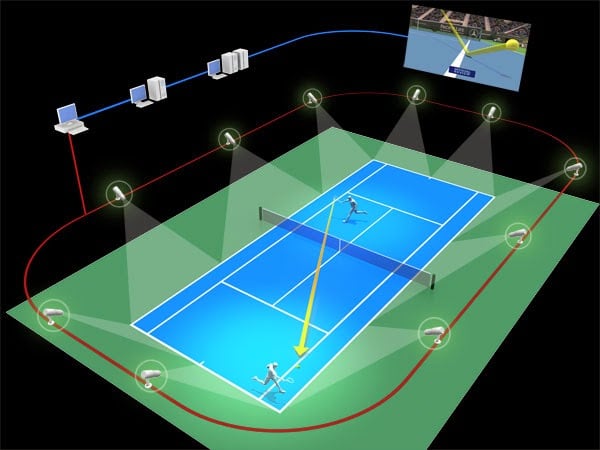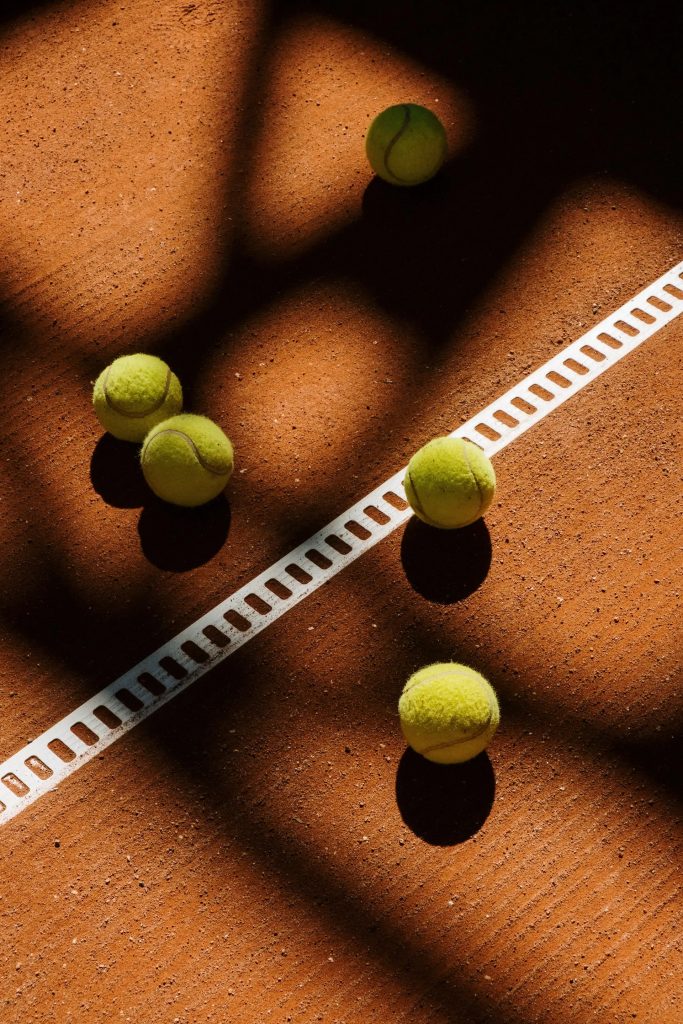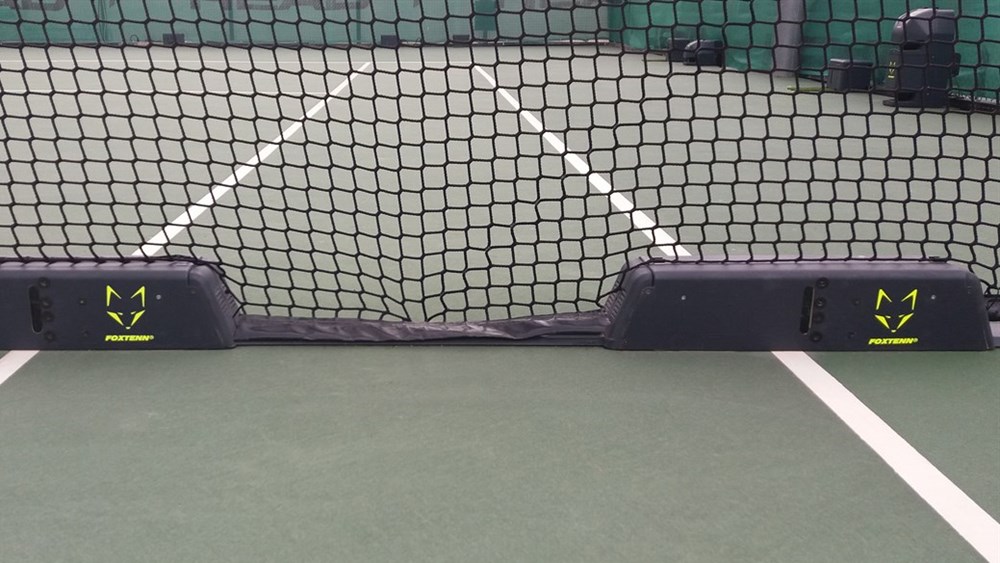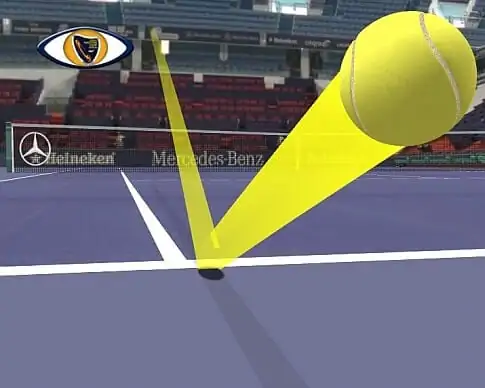Technology is becoming a hot topic in sports these last few months. The implementation of VAR in soccer and its application by referees is the subject of controversy and accusations every week on social networks.
Nevertheless, one of the experiments that has met with widespread approval is Hawk-Eye in tennis. So much so that it’s difficult to remember what tennis was like before it existed.
In the past, many people were reluctant to embrace the use of technology in sports, fearful that it could “undermine its essence”. However, Hawk-Eye has shown just how much technology can improve fairness in many sports.
This invention and its application didn’t just come out of nowhere. It was implemented after several regrettable errors that seriously affected the outcome of some very important matches, causing much frustration among the players.
Even though this Hawk-Eye technology is widely supported, a replacement (presumably an even more effective one) is already being developed. This is mainly because the current system has been the subject of several complaints, one of which was made by Diego Maradona himself!
Why was Hawk-Eye implemented in tennis?
Hawk-Eye was implemented on a regular basis in tennis from the year 2006, although it had been developed before that. But what was the real reason that brought it into regular use when the original intention was to introduce it a lot later?
Well, during the 2004 US Open, two renowned tennis players, Jennifer Capriati and Serena Williams, played one of the greatest matches of the tournament. Unfortunately, this match was plagued by several questionable decisions made by the main umpire.
Serena Williams protested about 3 different shots that were called out, and the replay system for spectators showed that she was right about all of them. This was all the more serious because Williams lost the match and was knocked out of the tournament. If Hawk-Eye had been used in that match, then it could have tipped the scales back in Serena’s favor.
What is Hawk-Eye and how is it used in tennis?
First of all, let’s talk about its origin. Hawk-Eye has its roots in Britain, and was first used in cricket and snooker.
As we all know, its purpose is to clarify where exactly the balls bounced. This allows umpires to determine whether a ball landed inside or outside the lines on the court. To accomplish this, the Hawk-Eye technology checks the trajectory and speed of the tennis ball, thus making it an extremely accurate gauge.
Hawk-Eye needs 10 cameras positioned around the court in order to work properly. These cameras are connected to computers that make all the necessary calculations to see where the ball bounced.
The moving image is created by the program and transmitted so that both judges and viewers can see the result at the same time.
Most importantly, this machine’s margin of error is low – between 2 and 3 millimeters. Because of this, it’s unlikely to make a mistake and disadvantage one of the players.
However, it should be noted that there are several types of tennis courts and Hawk-Eye isn’t used on clay courts. On clay courts, the impact of the ball is clearly visible on the surface and, if there is any uncertainty, or if the player requests it, then the umpires prefer to stop the match to go and have a closer look.
For this reason, tournaments such as Roland Garros or Monte-Carlo don’t use this system, which also has the advantage of nearly instant results.

Video refereeing in soccer or basketball can take 2 or 3 minutes, or even more, to confirm the decision. This slows down the pace of the game and the tension of an important point in the match can be lost.
On the other hand, in tennis, Hawk-Eye can give results in a matter of seconds. All it takes is for the player to make their ‘Challenge’, and, when the umpire has authorized it, everyone watches the Hawk-Eye images at the same time.
Of course, Hawk-Eye is used in soccer, to see if the ball has crossed the goal line, and it also gives results in seconds. The system sends a notification to the referee’s watch as to whether it was a goal, and does so almost immediately.
They’ve even introduced video refereeing in video games, to make the experience an even more realistic one.
What do tennis rules say about Hawk-Eye?
The International Tennis Federation (ITF) has decided to include Hawk-Eye in its official rules in order to avoid potential problems with the system in the future and to regulate its use in matches. The use of this electronic reviewing system has certain restrictions and must be carried out according to the following requirements:
- The player may request a review as long as it’s the final shot in a rally, or if they stop playing during a rally.
- The match umpire may also ask for a review of the shot if they aren’t sure about the line judge’s decision, or their own. The umpire may also reject the player’s request if they believe it to be unreasonable or if the player takes too long to ask for it.
- The referee’s original decision will stand if no decision can be reached based on the electronic review (this rule also applies if Hawk-Eye suddenly fails).
- The referee’s final decision after electronic review is binding, and cannot be appealed against.
- Each player has three challenges available per set. In addition, one more challenge is added in the event of a tiebreak. There are no limits regarding successful challenges, as they’re only deducted if the claim is unsuccessful.
Regarding all these rules, it’s important to highlight the immediacy factor. A famous piece of action involving Hawk-Eye occurred in a match between David Nalbandian and John Isner at the 2012 Australian Open.

The umpire ruled that the Argentine tennis player took too long to ask for a challenge. The umpire asked the Argentine if he wanted to ask for the challenge after the point was won, but he took a few seconds to decide.
Finally, Nalbandian decided to ask for the challenge after the umpire had announced the ‘Deuce’ scoreline.
The umpire ruled that Nalbandian had challenged the point too late and he refused to allow it. The Argentine was furious with the umpire and even Isner asked for a review of the shot, but the umpire flatly refused.
The funny thing about this incident is that the umpire had been following the rules correctly, so no matter how much he was criticized, he could never be accused of not observing the rules of the game.
A new system for the future?
As groundbreaking as Hawk-Eye may seem, there’s already another emerging technology that is challenging it and aiming to topple it from its lofty position in the tennis world.
The Spanish company FOXTENN has created a new video refereeing system that has already been approved by the ATP and WTA, which would include the 4 Grand Slams of the year.
Javier Simón is the man who created this system, and he explains that FOXTENN uses about 40 high-speed cameras, each capable of capturing more than 2,500 images per second.
The main difference between FOXTENN and Hawk-Eye is that the former has cameras that capture actual images of the ball’s bounce and don’t rely on tracking the ball’s trajectory.
Even though its creators don’t claim that it’s 100% error-proof, they do assure us that its margin of error is much smaller than Hawk-Eye’s. Besides this, it’s the only electronic review system that has been approved for use on clay courts, as well as for grass court tournaments, and it is claimed to be more precise than Hawk-Eye overall.
The cameras of this new system are strategically placed at court level to ensure a clear field of view of everything that happens on the court. They are housed in boxes that protect them from impact and any adverse weather effects.
As if that weren’t enough, these cameras also capture the players’ movements and analyze their on-court movements and performance. Because of this, it can automatically gather data about each player and provide reliable statistics.
At present, it isn’t known when the FOXTENN system will be first implemented in a major tournament, but it’s sure to create plenty of discussion.

Different opinions about Hawk-Eye in tennis
Earlier, we mentioned that Diego Maradona criticized Hawk-Eye, and it’s now time to clarify exactly what happened.
The incident took place in a 2016 Davis Cup match between Federico Delbonis and Marin Cilic in Argentina.
During the point in question, the umpire called one of Delbonis’ shots out. The Argentine challenged the call, and the umpire’s decision was upheld by the Hawk-Eye system, despite the image from the system not being too clear.
Maradona was incensed by the referee’s call, and his reaction was caught on camera. Here is the video:
However, there are other unusual cases when the players themselves resort to Hawk-Eye to make sure justice is done.
That was the case for Roger Federer in a match against Alexander Zverev in 2017. Zverev served and the linesman called the ball out.
Federer, surprised by the umpires’ decision, suggested to Zverev that he challenged the call. After the electronic review, the call was overturned and Zverev’s serve was deemed valid.
“It’s one of the great stars in the tennis world”, Spanish tennis player Carlos Moya once commented, highlighting the importance that electronic reviewing had taken on and the excitement it has created.
“I would completely do away with Hawk-Eye”. This was the legendary quote from U.S. tennis legend Andy Roddick in an interview with CNN in 2014, arguing that it goes against the very essence of the sport, which includes being able to argue with the match umpire.
The opinions of tennis players and ex-professionals regarding Hawk-Eye are many and varied. Even though it has its critics, it meets with the general approval of most, despite its occasional failures.
Challenges and how they heighten the excitement
Even though it takes no more than a few seconds to see a replay of a shot with Hawk-Eye, the introduction of player challenges has added an extra level of tension and excitement to the game.
In the past, the referee made their decision and it couldn’t be reversed. However, with Hawk-Eye technology, no verdict is final.
When a player challenges a call, both the spectators and the players experience tension that could only be created by this type of situation. We all know how crucial a point can be in a tennis match, and we all know we’re just seconds away from finding out if the decision is going to be reversed or upheld.
A clear example was the aforementioned match between Alexander Zverev and Roger Federer, in which the last point was decided by Hawk-Eye.
This element of excitement didn’t exist before in tennis matches, and it’s another of the great benefits of having embraced technology in the world of sport.
Tennis, at the forefront of refereeing developments
Tennis has undoubtedly been a pioneering sport in terms of technology around the world.
At the start of the 2000s, when other sports had hardly started to talk about the inclusion of video systems in refereeing, Hawk-Eye had already been used in tennis at the most prestigious international tournaments.
In fact, it’s thanks to tennis and other sports such as American football that sports like soccer and baseball have made the leap to create their own systems.
The users’ and players’ positive response to the implementation of Hawk-Eye also made tennis an example of transparency in the world of sport.
It isn’t in the best interests of any sport for its reputation to be tainted by refereeing errors. This can give rise to accusations that can easily spread, thus spoiling its public image.
This also applies to the rules of the game. Time limits have been put in place to improve the flow of the game and make tennis a more dynamic and attractive sport.
Additionally, there is also the ATP Next-Gen tournament, which is attended by the young tennis prospects from around the world who have trained in the best tennis camps like Ertheo’s tennis camps. In this tournament, alternative rules to the ones already known are applied to experiment with feedback from the players and the general audience, always seeking innovation.
The best thing of all is that tennis never stands still and is always searching for ways to be even fairer with its umpiring. Whether this is with the FOXTENN system or another one that will surely be invented in the future, it’s unquestionable that tennis will continue to be a leader in the technological arena with respect to its peers.
And just so that you can judge for yourself the use of Hawk-Eye in tennis, we would like to share a video with you of the worst “Hawk-Eye” challenges ever:
Do you know how to choose a tennis racket?
A tennis player’s most important “weapon” is their racquet, which is why it’s crucial to choose the right one when you first start playing tennis. If you make the wrong choice, you may lose interest in playing because of bad experiences at the start.
There are three main types of racquets, depending on whether the players are beginners, intermediate, or advanced. Other factors will determine what racquet to buy, this article will provide comprehensive information on the various types of racquets designed for beginners, intermediate, and advanced players, which also explains the influence of the different materials used in the racquet’s manufacture. If you want to be certain of choosing the best racquet for you, click above and find out!

